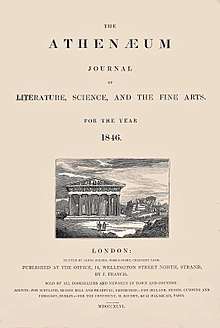The Athenaeum (British magazine)
The Athenæum was a literary magazine published in London, England from 1828 to 1921.

Foundation
Initiated in 1828 by James Silk Buckingham, it was sold within a few weeks to Frederick Maurice and John Sterling, who failed to make it profitable. In 1829, Charles Wentworth Dilke became part proprietor and editor; he greatly extended the influence of the magazine. In 1846, he resigned the editorship and assumed that of the Daily News of London, but contributed a series of notable articles to the Athenaeum. The poet and critic Thomas Kibble Hervey succeeded Dilke as editor and served from 1846 until his resignation due to ill health in 1853. Historian and traveller William Hepworth Dixon succeeded Hervey in 1853, and remained editor until 1869.
Contributors
George Darley was a staff critic during the early years, and Gerald Massey contributed many literary reviews – mainly on poetry – during the period 1858 to 1868. Theodore Watts-Dunton contributed regularly as the principal critic of poetry from 1875 until 1898. Frederic George Stephens was art editor from 1860 until 1901, when he was replaced by Roger Fry because of his unfashionable disapproval of Impressionism; Stephens continued to contribute book reviews and obituaries until 1904. Arthur Symons joined the staff in 1891.
Editor from 1871 to 1900 was Norman MacColl.[1] During the 19th century, the Athenaeum received contributions from Lord Kelvin. During the early 20th Century, its contributors included Max Beerbohm, Edmund Blunden, T. S. Eliot, Robert Graves, Thomas Hardy, Aldous Huxley, Julian Huxley, Katherine Mansfield, George Santayana, Edith Sitwell, and Virginia Woolf.
From 1849 to 1880 Geraldine Jewsbury contributed more than 2300 reviews. She was one of very few women who reviewed for the Athenaeum and started submitting her reviews regularly by 1854. She rated highly novels that showed character morality and were also entertaining. She criticized the "fallen woman" theme, which was common in Victorian literature. During the second half of the 1850s, Jewsbury was entrusted with editing the "New Novels" section.[2]
Legacy
A letter from J. S. Cotton, reportedly printed during 1905, definitively tells of the first-ever reference to the playing of a match of cricket in India.
In 1921, with decreasing circulation, the Athenaeum was incorporated into its younger competitor: the Nation, becoming The Nation and Athenaeum. In 1931, this successor publication merged with the New Statesman, to form the New Statesman and Nation, eliminating the name Athenaeum after 97 years.
References
- Murphy, G. Martin. "MacColl, Norman". Oxford Dictionary of National Biography (online ed.). Oxford University Press. doi:10.1093/ref:odnb/34689. (Subscription or UK public library membership required.)
- Fryckstedt, Monica Correa (1986). Geraldine Jewsbury's "Athenaeum" Reviews: A Mirror of Mid-Victorian Attitudes to Fiction. Stockholm: Almqvist Och Wiksell.
Further reading
- Demoor, Marysa, Their Fair Share: Women, Power, and Criticism in the Athenaeum, from Millicent Garratt Fawcett to Katharine Mansfield, 1870–1920. Aldershot: Ashgate, 2000. ISBN 978-0-7546-0118-0
- Graham, Walter James, 'The Athenaeum', "English Literary Periodicals". New York: T. Nelson, 1930, pp. 317–21.
- Hancock-Beaulieu, Micheline; Holland, Susan (1991). "Indexing The Athenaeum: aims and difficulties" (PDF). The Indexer. 17 (3): 167–172.
- Marchand, Leslie A., "The Athenaeum: A Mirror of Victorian Culture". Chapel Hill: University of North Carolina Press, 1941.
- Sullivan, Alvin, ed., 'The Athenaeum', "British Literary Magazines. Volume 3". Westport, Connecticut: Greenwood Press, 1983-, pp. 21–24.
External links
- A selection of Gerald Massey's literary reviews for the Athenaeum
- The Athenaeum Projects: Centre for Interactive Systems Research, City University, London - an index of all literary reviews from 1830-1870 - and all scientific reviews from 1828-1830.
- Athenaeum review of George Eliot's The Mill on the Floss by Geraldine Jewsbury, (April 7, 1860).